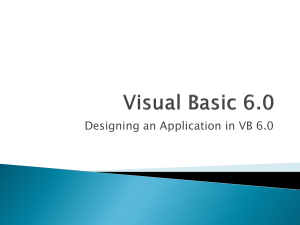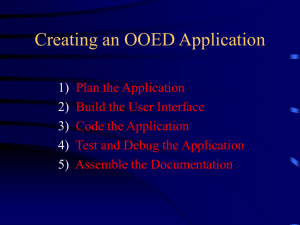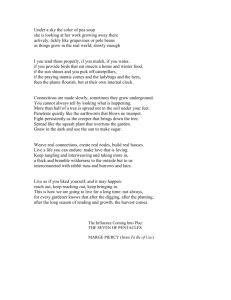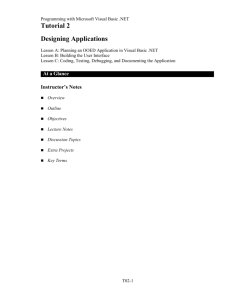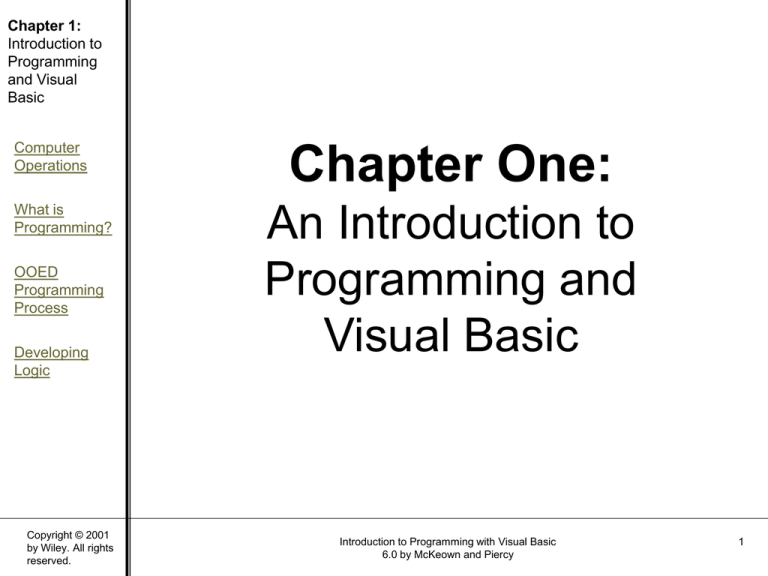
Chapter 1:
Introduction to
Programming
and Visual
Basic
Computer
Operations
What is
Programming?
OOED
Programming
Process
Developing
Logic
Copyright © 2001
by Wiley. All rights
reserved.
Chapter One:
An Introduction to
Programming and
Visual Basic
Introduction to Programming with Visual Basic
6.0 by McKeown and Piercy
1
Chapter 1:
Introduction to
Programming
and Visual
Basic
Computer
Operations
What is
Programming?
OOED
Programming
Process
Developing
Logic
Copyright © 2001
by Wiley. All rights
reserved.
Learning Objectives
• Understand the importance of information systems
in organizations.
• Discuss the role of computer programs and
programming in information systems.
• List and discuss the six computer operations.
• Describe the difference between modern Windowsbased computer languages and older procedural
languages.
• Discuss the difference between compiled and
interpreted languages.
• List and discuss the steps in the object-oriented,
event-driven programming process.
Introduction to Programming with Visual Basic
6.0 by McKeown and Piercy
2
Chapter 1:
Introduction to
Programming
and Visual
Basic
Computer
Operations
What is
Programming?
OOED
Programming
Process
Developing
Logic
Copyright © 2001
by Wiley. All rights
reserved.
Data and Information
• Data are raw facts
• Examples of data include transactions, dates,
amounts, etc.
• Information are data that have been processed into
a usable form
• Information includes tables, documents, charts, etc.
• Goal of computer applications is to process data
into information
Introduction to Programming with Visual Basic
6.0 by McKeown and Piercy
3
Chapter 1:
Introduction to
Programming
and Visual
Basic
Computer
Operations
What is
Programming?
OOED
Programming
Process
Developing
Logic
Six Basic Computer Operations
1. A computer can receive (input) data
2. A computer can store data in memory
3. A computer can perform arithmetic and manipulate
text strings
4. A computer can compare the contents of two
memory locations and select one of two
alternatives
5. A computer can repeat a group of operations
6. A computer can output information (processed
data)
We will use pseudocode statements to demonstrate
these six operations.
Copyright © 2001
by Wiley. All rights
reserved.
Introduction to Programming with Visual Basic
6.0 by McKeown and Piercy
4
Chapter 1:
Introduction to
Programming
and Visual
Basic
Computer Operations
Computer
Operations
What is
Programming?
OOED
Programming
Process
Developing
Logic
Copyright © 2001
by Wiley. All rights
reserved.
Introduction to Programming with Visual Basic
6.0 by McKeown and Piercy
5
Chapter 1:
Introduction to
Programming
and Visual
Basic
Computer
Operations
What is
Programming?
OOED
Programming
Process
Developing
Logic
Copyright © 2001
by Wiley. All rights
reserved.
Programs and Programming
A program is a very specific set of rules that
tell the computer which switches should be
"ON" or "OFF".
The process of creating a program is called
programming.
The computer only knows what it is told
through programs, so they must be accurate
and very specific.
Introduction to Programming with Visual Basic
6.0 by McKeown and Piercy
6
Chapter 1:
Introduction to
Programming
and Visual
Basic
Computer
Operations
What is
Programming?
OOED
Programming
Process
Developing
Logic
Copyright © 2001
by Wiley. All rights
reserved.
What is Programming?
• Deciding if there is a task to be accomplished or problem to
be solved using a computer, e.g., is there a need for a
program?
• Determining the nature of the task or problem, e.g., what
must the program do?
• Developing a plan that will accomplish the task or solve the
problem, e.g., generating the step-by-step process that the
program will follow (algorithm).
• Converting the plan into a computer language program
• Testing the program to ensure it accomplishes task or solves
problem defined earlier.
• Implementing the program to accomplish the task or solve the
problem.
Introduction to Programming with Visual Basic
6.0 by McKeown and Piercy
7
Chapter 1:
Introduction to
Programming
and Visual
Basic
Computer
Operations
What is
Programming?
OOED
Programming
Process
Developing
Logic
Types of Computer Languages
Procedural: Monolithic programs that run from start
to finish with no intervention from user other than
input
Basic, QBasic, QuickBasic
COBOL
FORTRAN
C
Object Oriented/Event Driven (OOED): Programs
that use objects which respond to events; use
small segments to code for each object
Visual Basic
Visual C++
Copyright © 2001
by Wiley. All rights
reserved.
Introduction to Programming with Visual Basic
6.0 by McKeown and Piercy
8
Chapter 1:
Introduction to
Programming
and Visual
Basic
Computer
Operations
What is
Programming?
OOED
Programming
Process
Developing
Logic
Levels of Computer
Languages
Low Level: at the level of the computer, i.e., in binary (0-1)
format Computer can only execute a binary form of a program
Intermediate Level: close to the computer but uses English
words or mnemonics, e.g., Assembler, that is converted
directly into binary
High Level: at the level of the programmer using English words
and clearly defined syntax; must be converted or translated
into binary for computer to implement it, e.g., Visual Basic
Need a software program to handle the conversion of high-level
into binary
Copyright © 2001
by Wiley. All rights
reserved.
Introduction to Programming with Visual Basic
6.0 by McKeown and Piercy
9
Chapter 1:
Introduction to
Programming
and Visual
Basic
Translating from High-level
Language to Binary
Computer
Operations
What is
Programming?
OOED
Programming
Process
Developing
Logic
Copyright © 2001
by Wiley. All rights
reserved.
Interpreted: each statement translated as it is
executed--slow but easy to use
Compiled: entire program is converted to
binary--executes faster, but more difficult to
use (.exe files are compiled programs)
VB is interpreted during creation and testing
but can then be compiled into an .exe file
Introduction to Programming with Visual Basic
6.0 by McKeown and Piercy
10
Chapter 1:
Introduction to
Programming
and Visual
Basic
Computer
Operations
What is
Programming?
OOED
Programming
Process
Total = 0
Current = 100
do while current <> 0
Total = Total + Current
Current = Current - 1
Loop
Translation
Program
High level
language program
10111000
101110001 00000000
01100100
00000001 11001000
01001001
01110101 11111011
Machine language
progam
Developing
Logic
Copyright © 2001
by Wiley. All rights
reserved.
Introduction to Programming with Visual Basic
6.0 by McKeown and Piercy
11
Chapter 1:
Introduction to
Programming
and Visual
Basic
Computer
Operations
What is
Programming?
OOED
Programming
Process
Developing
Logic
Copyright © 2001
by Wiley. All rights
reserved.
Object-Oriented Event-driven
Programming (OOED)
OOED uses objects, or self contained modules that combine
data and program code which pass strictly defined messages
to one another.
OOED is easier to work with, because it is more intuitive than
traditional programming methods.
Visual Basic is an OOED language.
Users can combine the objects with relative ease to create new
systems or extend existing ones.
Properties of objects are attributes associated with an object.
Methods of objects are those activities that the object can carry
out.
Objects respond to events.
Introduction to Programming with Visual Basic
6.0 by McKeown and Piercy
12
Chapter 1:
Introduction to
Programming
and Visual
Basic
Computer
Operations
What is
Programming?
OOED
Programming
Process
Developing
Logic
OOED Programming Process
A six step process for writing an OOED computer
program:
1. Define problem.
2. Create interface
3. Develop logic for action objects
4. Write and test code for action objects
5. Test overall project
6. Document project in writing
No matter how well a program is written, the objective
is not achieved if the program solves the wrong
problem.
Copyright © 2001
by Wiley. All rights
reserved.
Introduction to Programming with Visual Basic
6.0 by McKeown and Piercy
13
Chapter 1:
Introduction to
Programming
and Visual
Basic
Computer
Operations
What is
Programming?
OOED
Programming
Process
Developing
Logic
Copyright © 2001
by Wiley. All rights
reserved.
Step One: Define Problem
• Before you can create a computer application to solve a
problem, you must first clearly define it.
• This may involve a study of the problem to understand the
inputs and outputs.
• Must identify the data to be input to the program and the
results to be output from it.
• Sketching an interface is a good way to understand the
problem and to communicate your understanding to other
people.
• Denote input and output objects as well as action objects-those for which code (instructions) are needed.
Introduction to Programming with Visual Basic
6.0 by McKeown and Piercy
14
Chapter 1:
Introduction to
Programming
and Visual
Basic
Sketch of Vintage Video Interface
Computer
Operations
What is
Programming?
Vintage Videos
Price
OOED
Programming
Process
Input
Taxes
Amount Due
Developing
Logic
Action Objects
Calculate
Copyright © 2001
by Wiley. All rights
reserved.
Output
Exit
Introduction to Programming with Visual Basic
6.0 by McKeown and Piercy
15
Chapter 1:
Introduction to
Programming
and Visual
Basic
Computer
Operations
What is
Programming?
OOED
Programming
Process
Developing
Logic
Copyright © 2001
by Wiley. All rights
reserved.
Step Two: Create Interface
• Once you have defined problem and sketched
interface, you are ready to create interface.
• Doing this with VB is quite easy--select objects and
place them on VB form following sketch.
• For Vintage Video, only need three objects:
– buttons for action
– textboxes for input and output
– labels for descriptors
Introduction to Programming with Visual Basic
6.0 by McKeown and Piercy
16
Chapter 1:
Introduction to
Programming
and Visual
Basic
Vintage Video Interface
Computer
Operations
What is
Programming?
OOED
Programming
Process
Developing
Logic
Copyright © 2001
by Wiley. All rights
reserved.
Introduction to Programming with Visual Basic
6.0 by McKeown and Piercy
17
Chapter 1:
Introduction to
Programming
and Visual
Basic
Computer
Operations
What is
Programming?
OOED
Programming
Process
Developing
Logic
Copyright © 2001
by Wiley. All rights
reserved.
Step Three: Develop Logic for
Action Objects
• Need to think about what each action object should
do in response to an event
• This is the logic for each object
• Use Input/Processing/Output (IPO) Tables and
Pseudocode to develop the logic
• IPO Tables show the inputs, outputs, and the
processing to convert inputs into outputs
Introduction to Programming with Visual Basic
6.0 by McKeown and Piercy
18
Chapter 1:
Introduction to
Programming
and Visual
Basic
IPO Table for Calculate Button
Computer
Operations
What is
Programming?
Input
OOED
Programming
Process
Processing
Output
Video price Taxes = 0.07 x Price
Taxes
Amount due = Price + Taxes Amount due
Developing
Logic
Copyright © 2001
by Wiley. All rights
reserved.
Introduction to Programming with Visual Basic
6.0 by McKeown and Piercy
19
Chapter 1:
Introduction to
Programming
and Visual
Basic
Computer
Operations
What is
Programming?
OOED
Programming
Process
Developing
Logic
Copyright © 2001
by Wiley. All rights
reserved.
Using Pseudocode
• An important part of the developing the logic for
action objects is generating corresponding
pseudocode.
• Pseudocode involves actually writing a program in
English rather than in a computer language.
• When the actual computer program is written, the
pseudocode is translated into computer language.
• A pseudocode program is useful for two reasons:
– The programmer may use it to structure the
algorithm's logic in writing.
– It provides a relatively direct link between the
algorithm and the computer program
Introduction to Programming with Visual Basic
6.0 by McKeown and Piercy
20
Chapter 1:
Introduction to
Programming
and Visual
Basic
Computer
Operations
What is
Programming?
OOED
Programming
Process
Developing
Logic
Copyright © 2001
by Wiley. All rights
reserved.
Pseudocode for Calculate Button
Begin procedure
Input Video Price
Taxes = 0.07 x Video Price
Amount Due = Video Price + Taxes
Output Taxes and Amount Due
End procedure
Introduction to Programming with Visual Basic
6.0 by McKeown and Piercy
21
Chapter 1:
Introduction to
Programming
and Visual
Basic
Computer
Operations
What is
Programming?
OOED
Programming
Process
Developing
Logic
Copyright © 2001
by Wiley. All rights
reserved.
Step Four: Write and Test Code of
Action Objects
• Once you learn the vocabulary and syntax of a
language, you should be able to convert the logic
embodied in the pseudocode into a computer
language. In our case, we use VB.
• You need to test each code for each action object
as they are created.
• Once the object code is written, the programmer
must test and correct it. This stage is referred to as
debugging, since it involves removing "bugs".
• Use test data for which you know the correct
answer to test the object code.
Introduction to Programming with Visual Basic
6.0 by McKeown and Piercy
22
Chapter 1:
Introduction to
Programming
and Visual
Basic
Computer
Operations
What is
Programming?
OOED
Programming
Process
Developing
Logic
Copyright © 2001
by Wiley. All rights
reserved.
VB Code for Calculate Button
Private Sub cmdCalc_Click()
‘ This object calculates the Taxes and Amount
‘ Due given the Video Price
Dim curPrice as Currency, curTaxes as Currency
Dim curAmountDue as Currency
curPrice = Val(txtVideoPrice.Text )
curTaxes = 0.07* curPrice
curAmountDue = curPrice + curTaxes
txtTaxes.Text = Str(curTaxes)
txtAmountDue.Text = Str(curAmountDue)
End Sub
Introduction to Programming with Visual Basic
6.0 by McKeown and Piercy
23
Chapter 1:
Introduction to
Programming
and Visual
Basic
Computer
Operations
What is
Programming?
OOED
Programming
Process
Developing
Logic
Copyright © 2001
by Wiley. All rights
reserved.
Step Five: Test Overall Project
• Even with extensive testing, some bugs can often
be found in most commercial software.
• With computer software, each program instruction
must be absolutely correct. Otherwise, the whole
program might fail.
• BE SURE to test your program in the actual
environment and on the actual data on which it will
be used (just ask IBM at the Olympics).
Introduction to Programming with Visual Basic
6.0 by McKeown and Piercy
24
Chapter 1:
Introduction to
Programming
and Visual
Basic
Computer
Operations
What is
Programming?
OOED
Programming
Process
Developing
Logic
Copyright © 2001
by Wiley. All rights
reserved.
Step Six: Document Project in Writing
• Documentation includes the pictorial and written
descriptions of the software. It contains internal
descriptions of programming commands and
external descriptions and instructions.
• Documentation is necessary since, sooner or later,
the program will need to be maintained (correct
bugs, add new features, handle problems not
thought of previously, etc. This is NOT possible
without documentation.
• Written documentation includes books, manuals,
and pamphlets that give instructions on software
use and discuss the objectives and logic of the
software.
Introduction to Programming with Visual Basic
6.0 by McKeown and Piercy
25

